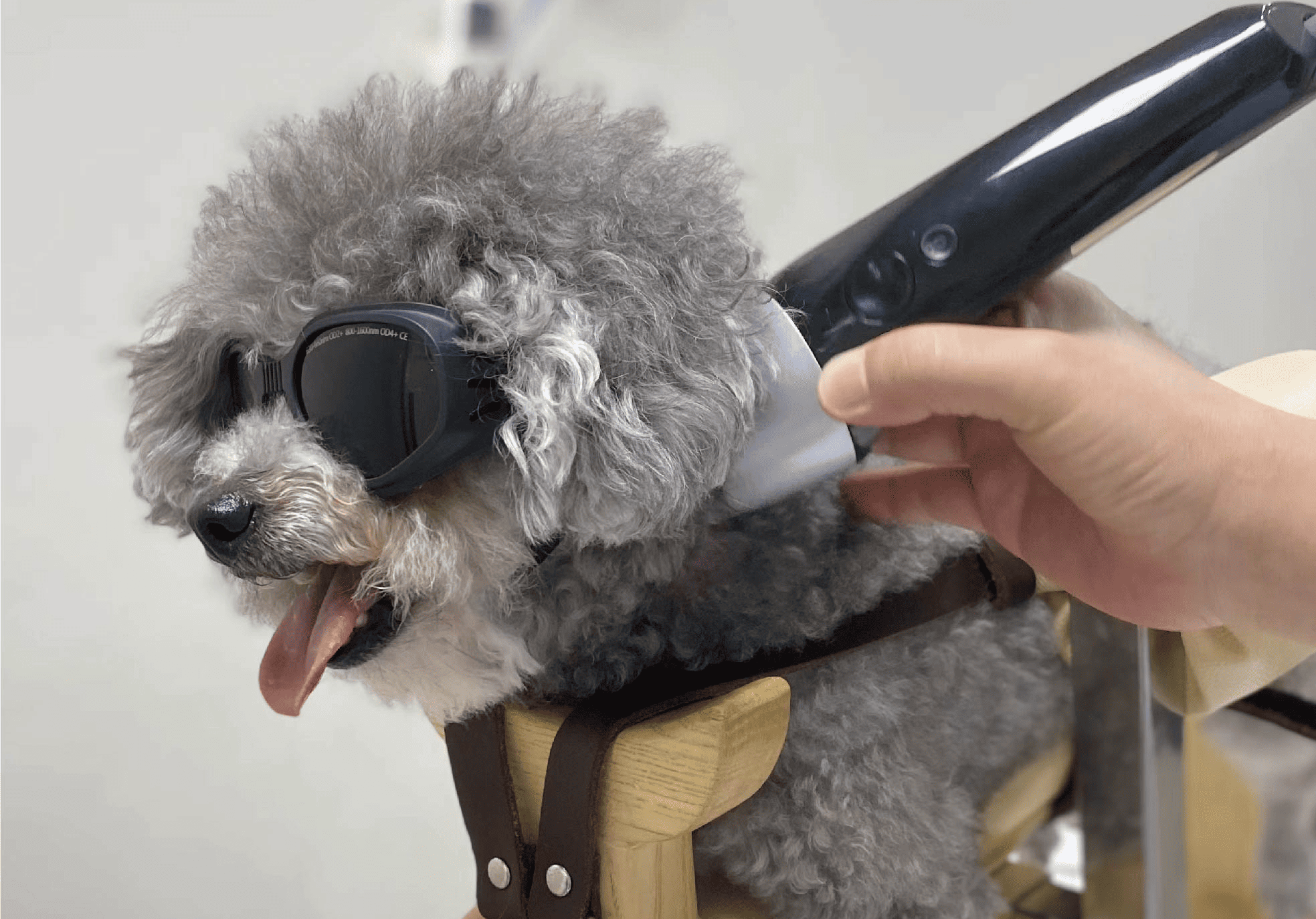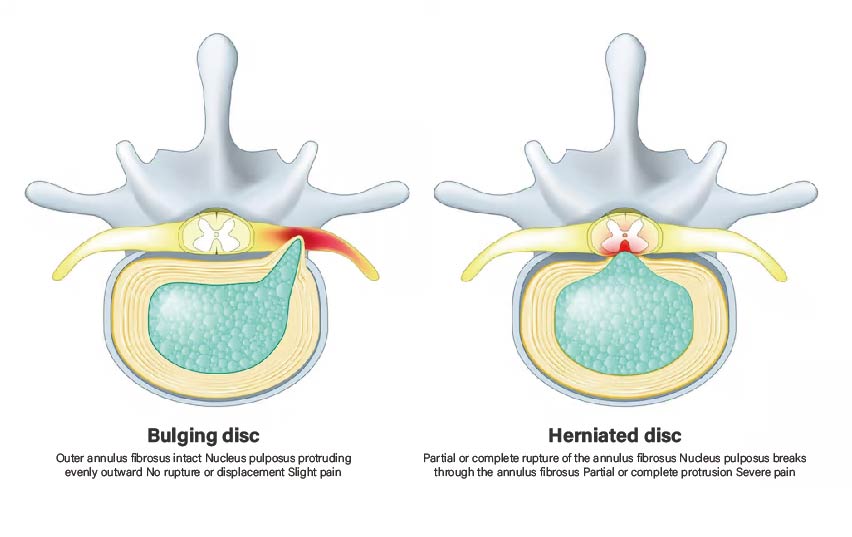Does Laser Therapy Work for a Canine Bulging Discs?

In veterinary practice, canine intervertebral disc bulging (IVD bulging) is a common vertebral disease that is prone to recurrence and has a significant impact on the quality of life, and the resulting daily pain in dogs has become a problem for many pet owners. In recent years, laser therapy, as an emerging non-invasive therapy, has attracted attention in assisting pain relief and promoting functional recovery. In this article, we will systematically analyze its therapeutic effect and current application.
What is a dog bulging disc?
Canine bulging disc is a condition in which the outer fibrous annulus of the intervertebral disc gradually deteriorates, loses elasticity and thickens, causing the entire disc to bulge outward evenly into the spinal canal. When the disc material presses on the neural structures, it can cause limited movement and spinal stiffness in mild cases, lameness, weakness of the limbs (especially the hind limbs), and an unsteady gait in moderate cases, and partial or complete paralysis, or even numbness and loss of consciousness in the limbs in severe cases. Discs do not have a direct blood supply like most parts of the body, which means that healing will be very slow without external intervention.
What is the difference between bulging discs and herniated discs?
Intervertebral bulging discs, also known as prolapsed intervertebral discs, and herniated discs are two common conditions in spinal disorders. Bulging discs are an early manifestation of disc degeneration, while herniated discs are a more serious stage. The main difference lies in the degree of pathological changes and manifestations:
A bulging disc is mainly characterized by an intact outer fibrous annulus, with the inner nucleus pulposus still intact within the annulus fibrosus protruding outward uniformly without rupture or displacement. In herniated disc, the annulus fibrosus is partially or completely ruptured, and the nucleus pulposus breaks through the annulus fibrosus and extrudes partially or completely, thus compressing the surrounding nerve roots or spinal cord.
The symptoms and pain of a bulging disc are usually less severe than those of a herniated disc. In the early stages of a bulging disc, there are no obvious symptoms, and some patients only feel mild pain or stiffness. In a herniated disc, the pain is often more intense and concentrated, and is often accompanied by clear signs of nerve compression, such as limb numbness, muscle atrophy, and abnormal reflexes.

How does laser therapy treat dog bulging discs?
Laser therapy is an emerging painless, non-invasive, drug-free, non-surgical, and side-effect-free solution. It stimulates the bulging disc area through laser irradiation, thereby promoting natural healing. Laser therapy is able to regulate the immune response, improve axonal function and neural support function, and has targeted therapeutic effects on acute spinal cord injuries, which can effectively shorten post-operative recovery time.
Specific wavelengths of laser light precisely stimulate the cells, stimulating the intracellular repair mechanism and initiating the healing process at the molecular level. This process not only provides more energy and nutrients to the repair cells, but also effectively improves the symptoms of lumbar spine pain, edema and numbness, and inhibits the inflammatory reaction, accelerating the repair process of the damaged area.
With its anti-inflammatory and analgesic properties, laser therapy can be an important tool for conservative treatment when surgery is not the best option. Due to the fact that the entire treatment process is time consuming and pain relieving, laser therapy has become a mainstream choice in the field of physiotherapy.
How effective is laser therapy for dog bulging discs?
Laser therapy is an ideal non-invasive treatment. It relieves pain and speeds up the healing of damaged discs. The laser acts on the diseased area to provide anti-inflammatory, analgesic and swelling reduction effects. It relieves pain and swelling caused by bulging discs, improves local blood circulation and promotes the absorption of inflammatory mediators, thus reducing symptoms.
Laser treatment has many advantages over traditional surgery. The treatment time is significantly shorter, usually taking only about 10 minutes, depending on the condition. In addition, it promotes the production of endorphins, which have a positive effect on generalized pain relief, and the risk of post-treatment complications is significantly reduced.
Studies have shown that laser therapy has a success rate of more than 80% and no side effects. For acute bulging discs, significant results can be seen after 9 treatments (6 treatments once a day, then 3 treatments every other day), which can be extended to 6 treatments (1 every other day) depending on the condition; for chronic bulging discs, significant results can be seen after 12 treatments (6 treatments once a day, then 6 treatments every other day), with subsequent maintenance programs of 1 treatment per week.
How to treat a bulging disc in dogs with laser therapy?
It is important to determine the exact location and severity of the disc before starting laser treatment. Veterinarians will need to perform an MRI or CT scan to determine the location of the lesion, which is generally categorized as acute for up to two weeks and chronic for more than two weeks. Take the Skyline 4 laser therapy equipment as an example, it has 1,460 built-in options for laser treatment, and it is important to consider the patient's actual condition before selecting the appropriate option, taking into account the species of animal, the location of the lesion, the severity of the acute condition, and the weight of the animal. Laser treatment should be carried out under the guidance of a professional, and the contraindications to laser treatment should be fully understood to prevent irreversible consequences of incorrect operation.
Combining laser therapy with other treatments
Studies have shown that the interaction between laser therapy and other therapies, such as physical therapy, can have a synergistic effect, providing significant pain relief and accelerated healing. Currently, laser treatment for bulging discs is often used in conjunction with rehabilitation therapies such as acupuncture and massage. Acupuncture involves the insertion of fine needles into specific acupuncture points to stimulate a physiologic response, which increases blood flow, reduces muscle spasms, and relieves pain; massage therapy includes techniques such as joint mobilization and chiropractic care. Acupuncture treatment or massage therapy combined with laser physical therapy can shorten treatment time, reduce the number of treatments, increase treatment efficiency, and provide a more convenient and effective treatment experience for patients, as well as provide rapid pain relief and promote long-term spinal health.
Can I treat my dog's bulging disc at home?
Of course, Vaymed's V-Heal and Skyline class 4 laser therapy equipments are lightweight and portable for use at home, in the hospital and outdoors. The handheld V-Heal class 4 laser therapy device has an outstanding 3-hour battery life, while the Skyline class 4 laser therapy machine has a satchel design and is rechargeable with up to 12 hours of battery life.
References:
[1] A randomized double-blinded controlled trial on the effects of photobiomodulation therapy in dogs with osteoarthritis - João C. Alves, DVM, MSc, PhD; Ana Santos, DVM, MSc; Patrícia Jorge, DVM; L. Miguel Carreira, DVM, PhD
[2] Perilesional photobiomodulation therapy and physical rehabilitation in post-operative recovery of dogs surgically treated for thoracolumbar disc extrusion - Sara Canal; Michela Antonucci; Marco Bernardini; Federica Balducci; Vincenzo Musella; Matteo Mussoni; Giuseppe Spinella








